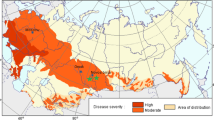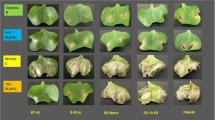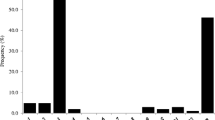Abstract
Blackleg, which is caused by the ascomycete fungus Leptosphaeria maculans, is a major disease of canola in Canada and worldwide. In Canada, canola is usually grown in rotation once every three to four years to limit yield losses. Recently, growers in Canada have begun to grow canola more intensively due to growing market demand driven by crop profitability and improved cultivars. A 4-year study at the Ian N. Morrison Research Station, Carman Manitoba, was conducted from 2014 to 2017 to investigate the effectiveness of five introgression lines (IL) carrying single blackleg resistance genes under field conditions in a 2-year canola–wheat rotation. Blackleg incidence for all tested R genes, except Rlm4, was reduced by a maximum of 16% in 2017 compared to 2014. Disease severity was 31–44% higher in the first year for all tested R genes, except for the Rlm2 when canola was seeded on the same stubble, compared to the fourth year rotation. Relative disease severity, calculated based on the susceptible check Westar, showed that the R genes LepR1, LepR3, Rlm2, and Rlm4 were resistant (<30% of check) against L. maculans after 4 years of rotation, whereas Rlm3 resistance was less effective (35% of check). The results of our 2-year rotation study suggest that canola cultivars harbouring the major resistance genes LepR1, LepR3, Rlm2, and Rlm4 will remain effective against blackleg when grown in the increasingly common 2-year rotation, rather than the recommended 3–4 year rotation. As expected, the regression analysis confirmed that seed yield declined as blackleg severity increased. However, comparatively some ILs were more impacted in terms of yield loss as disease severity increased, and can be ordered from the most to the least resistant as follows: Rlm2 ≈ LepR1 > Rlm3 ≈ Rlm4 > LepR3.






Similar content being viewed by others
References
Ansan-Melayah, D., Balesdent, M. H., Delourme, R., Pilet, M. L., Tanguy, X., Renard, M., et al. (1998). Genes for race-specific resistance against blackleg disease in Brassica napus L. Plant Breeding, 117, 373–378.
Bailey, K. L., Johnston, A. M., Kutcher, H. R., Gossen, B. D., & Morrall, R. A. A. (2000). Managing crop losses from foliar diseases with fungicides, rotation, and tillage in the Saskatchewan parkland. Canadian Journal of Plant Science, 80, 169–175.
Balesdent, M. H., Attard, A., Ansan-Melayah, D., Delourme, R., Renard, M., & Rouxel, T. (2001). Genetic control and host range of avirulence toward Brassica napus cultivars Quinta and jet Neuf in Leptosphaeria maculans. Phytopathology, 91, 70–76.
Balesdent, M. H., Louvard, K., Pinochet, X., & Rouxel, T. (2006). A large-scale survey of races of Leptosphaeria maculans occurring on oilseed rape in France. European Journal of Plant Pathology, 114, 53–65.
Balesdent, M. H., Fudal, I., Ollivier, B., Bally, P., Grandaubert, J., Eber, F., et al. (2013). The dispensable chromosome of Leptosphaeria maculans shelters an effector gene conferring avirulence towards Brassica rapa. New Phytology, 198, 887–898.
Brun, H., Chevre, A. M., Fitt, B. D. L., Powers, S., Besnard, A. L., Ermel, M., et al. (2010). Quantitative resistance increases the durability of qualitative resistance to Leptosphaeria maculans in Brassica napus. New Phytology, 185, 285–299.
[CCC] Canola Council of Canada (2017). Citing online sources: Canadian Canola Oil Export. Available from http://www.canolacouncil.org/markets-stats/statistics/historic-oil-exports/ (accessed August 10, 2020).
[CCC] Canola Council of Canada. (2020). Canada’s canola industry sets strategic plan for 2025. http://www.canolacouncil.org/markets-stats/market-access/ Accessed July 10, 2020.
Cathcart, R. J., Topinka, A. K., Kharbanda, P., Lange, R., Yang, R. C., & Hall, L. M. (2006). Rotation length, canola variety and herbicide resistance system affect weed populations and yield. Weed Science, 54, 726–734.
Cook, R. J. (2006). Toward cropping systems that enhance productivity and sustainability. Proceedings of the National Academy of Sciences of the United States of America, 103, 18389–18394.
Cornelsen, J., Zou, Z., Huang, S., Parks, P., Lange, R., Peng, G., & Fernando, W. G. D. (2021). Validating the strategic deployment of blackleg resistance gene groups in commercial canola fields on the Canadian prairies. Frontiers in Plant Science, 12, 902.
Curl, E. A. (1963). Control of plant diseases by crop rotation. The Botanical Review, 29, 413–479.
Daverdin, G., Rouxel, T., Gout, L., Aubertot, J. N., Fudal, I., Meyer, M., et al. (2012). Genome structure and reproductive behaviour influence the evolutionary potential of a fungal phytopathogen. PLoS Pathogen., 8, e1003020.
de Gruyter, J., Woudenberg, J. H. C., Aveskamp, M. M., Verkley, G. J. M., Groenewald, J. Z., & Crous, P. W. (2013). Redisposition of phoma-like anamorphs in Pleosporales. Studies in Mycology, 57, 1–36.
Dilmaghani, A., Balesdent, M. H., Didier, J. P., Wu, C., Davey, J., Barbetti, M. J., et al. (2009). The Leptosphaeria maculans - Leptosphaeria biglobosa species complex in the American continent. Plant Pathology, 58, 1044–1058.
Dokken-Bouchard, F. L., Anderson, K., Bassendowski, K. A., Bauche, C., Bouchard, A., Boyle, T., et al. (2011). Survey of canola diseases in Saskatchewan, 2010. Canadian Plant Disease Survey, 91, 120–123.
Dosdall, L. M., Harker, K. N., O’Donovan, J. T., Blackshaw, R. E., Kutcher, H. R., Gan, Y., et al. (2012). Crop sequence effects on root maggot (Diptera: Anthomyiidae: Delia spp.) infestations in canola. Journal of Economic Entomology, 105, 1261–1267.
Evans, N., Baierl, A., Semenov, M. A., Gladders, P., & Fitt, B. D. L. (2008). Range and severity of a plant disease increased by global warming. Journal of the Royal Society Interface, 5, 525–531.
Fernando, W. G. D., Zhang, X., Selin, C., Zou, Z., Liban, S. H., McLaren, D. L., et al. (2018). A six-year investigation of the dynamics of avirulence allele profiles, blackleg incidence, and mating type alleles of Leptosphaeria maculans populations associated with canola crops in Manitoba, Canada. Plant Disease, 102, 790–798.
Fitt, B. D. L., Brun, H., Barbetti, M. J., & Rimmer, S. R. (2006). World-wide importance of phoma stem canker (Leptosphaeria maculans and L. biglobosa) on oilseed rape (Brassica napus). European Journal of Plant Pathology, 114, 3–15.
Fudal, I., Ross, S., Brun, H., Anne-Laure, B., Ermel, M., Kuhn, M. L., et al. (2009). Repeat-induced point mutation (RIP) as an alternative mechanism of evolution towards virulence in Leptosphaeria maculans. Molecular Plant Microbe Interaction, 22, 932–941.
Ghanbarnia, K., Fernando, W. G. D., & Crow, G. (2009). Developing rainfall- and temperature-based models to describe infection of canola under field conditions caused by pycnidiospores of Leptosphaeria maculans. Phytopathology, 99, 879–886.
Ghanbarnia, K., Fernando, W. G. D., & Crow, G. (2011). Comparison of disease severity and incidence at different growth stages of naturally infected canola plants under field conditions by pycnidiospores of Phoma lingam as a main source of inoculum. Canadian Journal of Plant Pathology, 33, 355–363.
Harker, K. N., O’Donovan, J. T., Turkington, T. K., Blackshaw, R. E., Lupwayi, N. Z., Smith, E. G., et al. (2012). High-yield no-till canola production on the Canadian prairies. Canadian Journal of Plant Science, 92, 221–233.
Hwang, S. F., Strelkov, S. E., Peng, G., Ahmad, H., Zhou, Q., & Turnbull, G. (2016). Blackleg (Leptosphaeria maculans) severity and yield loss in canola in Alberta, Canada. Plants, 3, 31.
Johnston, A. M., Kutcher, H. R., & Bailey, K. L. (2005). Impact of crop sequence decisions in the Saskatchewan parkland. Canadian Journal of Plant Science, 85, 95–102.
Kutcher, H. R., Keri, M., McLaren, D. L., & Rimmer, S. R. (2007). Pathogenic variability of Leptosphaeria maculans in western Canada. Canadian Journal of Plant Pathology, 29, 388–393.
Kutcher, H. R., Yu, F., & Brun, H. (2010). Improving blackleg disease management of Brassica napus from knowledge of genetic interactions with Leptosphaeria maculans. Canadian Journal of Plant Pathology, 32, 29–34.
Kutcher, H. R., Brandt, S. A., Smith, E. G., Ulrich, D., Malhi, S. S., & Johnston, A. M. (2013). Blackleg disease of canola mitigated by resistant cultivars and four-year crop rotations in western Canada. Canadian Journal of Plant Pathology, 35, 209–221.
Larkan, N. J., Yu, F., Lydiate, D. J., Rimmer, S. R., & Borhan, M. H. (2016). Single R gene introgression lines for accurate dissection of the brassica-Leptosphaeria Pathosystem. Frontiers in Plant Science, 7, 1771.
Li, H., Barbetti, M. J., & Sivasithamparam, K. (2005). Hazard from reliance on cruciferous hosts as sources of major gene-based resistance for managing blackleg (Leptosphaeria maculans) disease. Field Crops Research, 91, 185–198.
Liban, S. H., Cross, D. J., Kutcher, H. R., Peng, G., & Fernando, W. G. D. (2016). Race structure and frequency of avirulence genes in the western Canadian Leptosphaeria maculans pathogen population, the causal agent of blackleg in brassica species. Plant Pathology, 65, 1161–1169.
LMC International. (2016). The Economic Impact of Canola on the Canadian Economy. pp. 2. Available from http://www.canolacouncil.org/media/584356/lmc_canola_10-year_impact_study_-_canada_final_dec_2016.pdf ().
Marcroft, S. J., Van de Wouw, A. P., Salisbury, P. A., Potter, T. D., & Howlett, B. J. (2012). Effect of rotation of canola (Brassica napus) varieties with different complements of blackleg resistance genes on disease severity. Plant Pathology, 61, 934–944.
O’Donovan, J. T., Grant, C. A., Blackshaw, R. E., Harker, K. N., Johnson, E. N., Gan, Y., et al. (2014). Rotational effects of legumes and non-legumes on hybrid canola and malting barley. Agronomy Journal, 106, 1921–1932.
Raman, H., Raman, R., & Larkan, N. (2013). Genetic dissection of blackleg resistance loci in rapeseed (Brassica napus L.) in plant breeding from laboratories to fields, ed S. B. Andersen (Rijeka: InTech), 85-120.
Rashid, M. H., Liban, S., Zhang, X., Parks, P., Hossein, B., & Fernando, W. G. D. (2020). Impact of Brassica napus-Leptosphaeria maculans interaction in the emergence of virulent isolates of L. maculans, a causal agent of blackleg disease in canola. Plant Pathology, 00, 1–16.
Rimmer, S. R., Kutcher, H. R., & Morrall, R. A. A. (2003). Diseases of canola and mustard. In Diseases of field crops of Canada. Bailey, K. L, Gossen, B.D., Gugel, R.K., Morrall, R.A.A. (Eds.) Saskatoon, SK. Canadian Phytopathology Society, 129–146.
Rouxel, T., Penaud, A., Pinochet, X., Brun, H., & Gout, L. (2003). A 10-year survey of populations of Leptosphaeria maculans in France indicates a rapid adaptation towards the Rlm1 resistance gene of oilseed rape. European Journal of Plant Pathology, 109, 871–881.
Schoeny, A., Jeuffroy, M. H., & Lucas, P. (2001). Influence of take-all epidemics on winter wheat yield formation and yield loss. Phytopathology, 91, 694–701.
Sprague, S. J., Balesdent, M. H., Brun, H., Hayden, H. L., Marcroft, S. J., Pinochet, X., et al. (2006). Major gene resistance in Brassica napus (oilseed rape) is overcome by changes in virulence of populations of Leptosphaeria maculans in France and Australia. European Journal of Plant Pathology, 114, 33–44.
Stachowiak, A., Olechnowicz, J., Jedryczka, M., Rouxel, T., Balesdent, M. H., Happstadius, I., et al. (2006). Frequency of avirulence alleles in field populations of Leptosphaeria maculans in Europe. European Journal of Plant Pathology, 114, 67–75.
Van de Wouw, A. P., Cozijnsen, A. J., Hane, J. K., Brunner, P. C., McDonald, B. A., Oliver, R. P., et al. (2010). Evolution of linked avirulence effectors in Leptosphaeria maculans is affected by genomic environment and exposure to resistance genes in host plants. PLoS Pathogen, 6, e1001180.
Van de Wouw, A. P., Lowe, R. G. T., Elliott, C. E., Dubois, D. J., & Howlett, B. J. (2014). An avirulence gene, AvrLmJ1, from the blackleg fungus, Leptosphaeria maculans, confers avirulence to Brassica juncea varieties. Molecular Plant Pathology, 15, 523–530.
Wang, Y., Strelkov, S. E., & Hwang, S. F. (2020). Yield losses in canola in response to blackleg disease. Canadian Journal of Plant Science, 100, 488–494.
West, J. S., Kharbanda, P., Barbetti, M. J., & Fitt, B. D. L. (2001). Epidemiology and management of Leptosphaeria maculans (phoma stem canker) in Australia, Canada and Europe. Plant Pathology, 50, 10–27.
West, J. S., Fitt, B. D. L., Leech, P. K., Biddulph, J. E., Huang, Y. J., & Balesdent, M. H. (2002). Effects of timing of Leptosphaeria maculans ascospore release and fungicide regime on phoma leaf spot and phoma stem canker development on winter oilseed rape (Brassica napus) in southern England. Plant Pathology, 51, 454–463.
Williams, P. H., & Delwiche, P. A. (1979). Screening for resistance to blackleg of crucifers in the seedling stage. Pages 164–170 in: Proceedings of a Eucarpia-conference on the breeding of cruciferous crops, Wageningen. The Netherlands.
Zhang, X., & Fernando, W. G. D. (2018). Insights into fighting against blackleg disease of Brassica napus in Canada. Crop & Pasture Science, 69, 40–47.
Zhang, X., Peng, G., Kutcher, H. R., Balesdent, M. H., Delourme, R., & Fernando, W. G. D. (2016). Breakdown of Rlm3 resistance in the Brassica napus–Leptosphaeria maculans pathosystem in western Canada. European Journal of Plant Pathology, 145, 659–674.
Acknowledgments
This work was funded by SaskCanola and AAFC-Growing Forward 2 programs. R genes introgression lines utilized in this study were developed at Dr. Borhan’s lab at the AAFC Saskatoon Research and Development Center. We would like to thank Alvin Iverson for his help in the field study at the Ian N. Morrison Research Station of the University of Manitoba.
Author information
Authors and Affiliations
Corresponding author
Ethics declarations
Ethics declaration
The research reported in this article did not have human or animal subjects.
Conflict of interest
The authors declare that they have no conflict of interest.
Supplementary Information
ESM 1
(DOC 69 kb)
Rights and permissions
About this article
Cite this article
Rashid, M.H., Liban, S.H., Zhang, X. et al. Comparing the effectiveness of R genes in a 2-year canola–wheat rotation against Leptosphaeria maculans, the causal agent of blackleg disease in Brassica species. Eur J Plant Pathol 163, 573–586 (2022). https://doi.org/10.1007/s10658-022-02498-7
Accepted:
Published:
Issue Date:
DOI: https://doi.org/10.1007/s10658-022-02498-7




